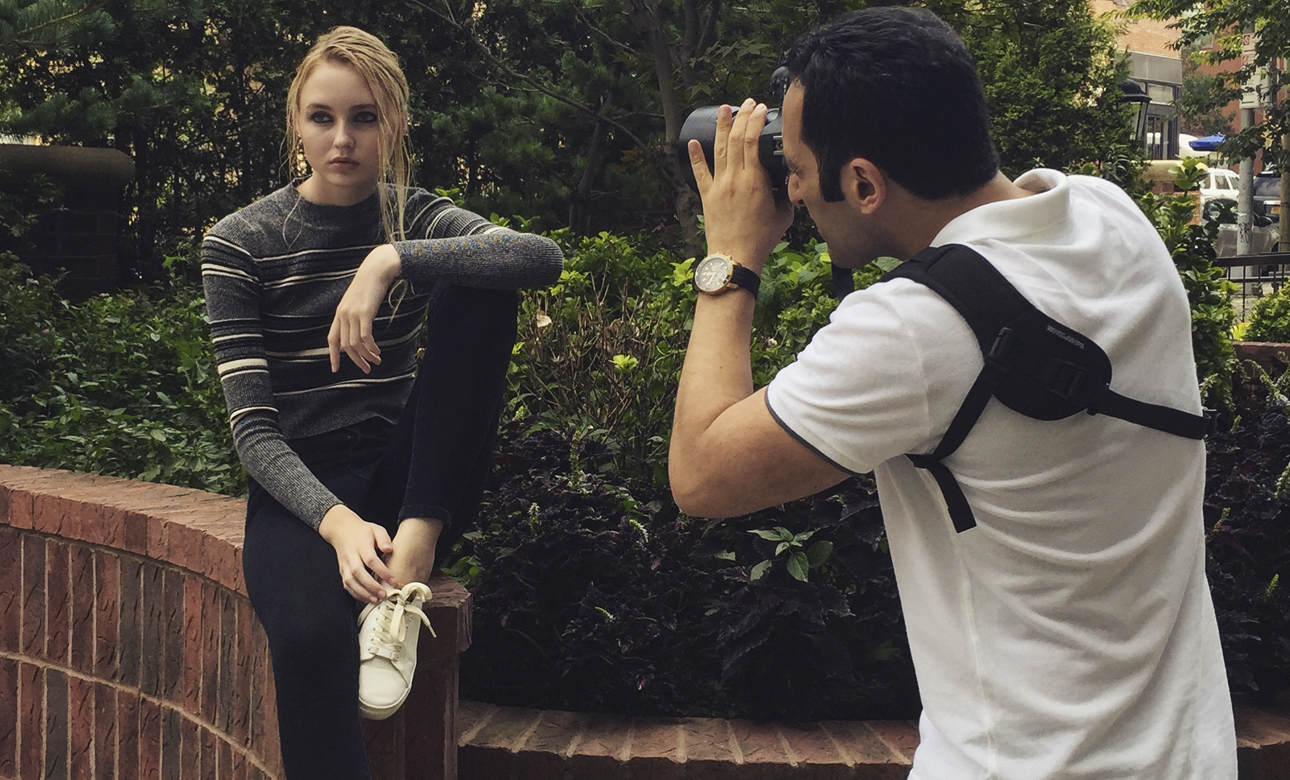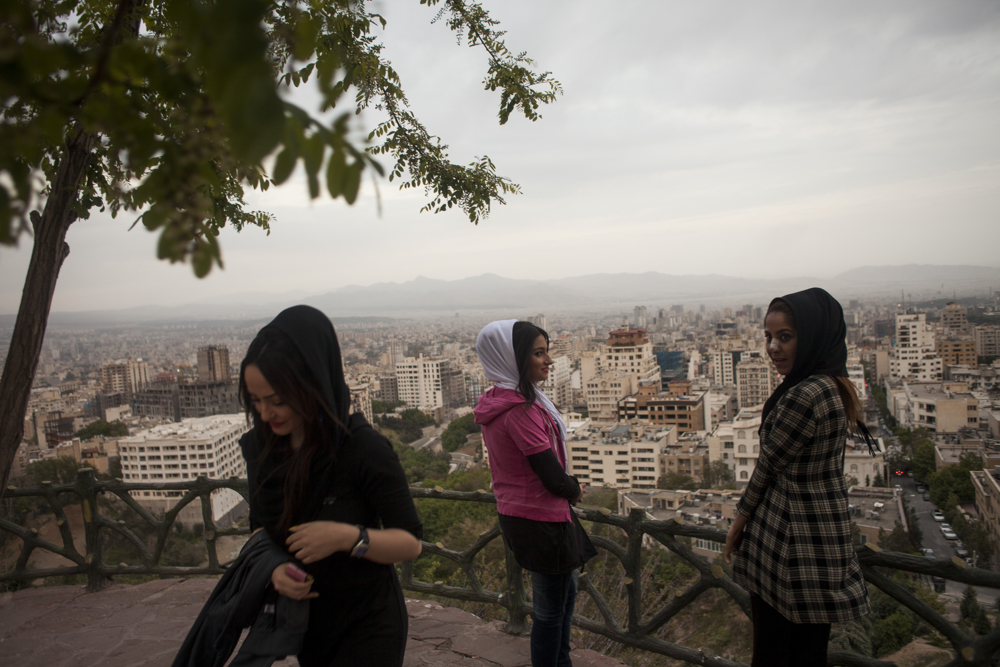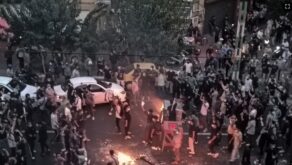Iranhumanrights.org – Iran’s Brain Drain Spreads to Fashion Sector as Professionals Emigrate to Escape Raids and Arrests
In the latest attack on the Islamic Republic’s growing fashion sector, a court in Shiraz sentenced 12 industry professionals in December 2016 to prison terms ranging from five months to six years.
An investigation by the International Campaign for Human Rights in Iran has revealed that the crackdown on the sector is ongoing, is being led by the Islamic Revolutionary Guards (IRGC) Intelligence Organization in concert with Iran’s Judiciary, and follows a decree by Supreme Leader Ali Khamenei against all forms of perceived western culture.
Following raids organized by the Guards, dozens of people have been interrogated about alleged “modeling networks” while businesses have been shuttered in the cities of Tehran, Qazvin, Arak, Shiraz and Zahedan.
“After they’re summoned, the authorities first order them to log into their Instagram page and delete their account,” said a Tehran-based industry source who spoke to the Campaign about four colleagues who were summoned in November 2016 to answer questions about alleged “immoral” activities. “The authorities also identify people as potential targets by looking at the detainee’s list of Instagram followers and contacts.”
A women’s dress designer in Tehran told the Campaign: “It’s hard to estimate how many have been summoned and harassed by the Revolutionary Guards because it’s bad for business and they’re afraid of losing customers, so no one talks about it. Only a few might tell their friends that the authorities have contacted them, otherwise, they’re careful not to get trapped. Probably the only way you can find out something has gone wrong is when there’s a sudden change on someone’s Instagram page.”
For security reasons, the sources interviewed by the Campaign for this briefing paper asked to remain anonymous.
To legally work in Iran’s fashion industry, people must apply for professional permits including in the fields of photography, design and hairdressing. Specialized organizations and laws regulate the industry. Members must be particularly careful not to engage in activities that could be interpreted as anti-Islamic or Western.
The internet, which is heavily filtered by state authorities, has provided industry members with an outlet for self-promotion, but it is also risky one due to the fact that social media platforms are continuously monitored by state authorities. Many members have launched pages on Instagram, which is one of the few major unfiltered Western-based social media application allowed in the Islamic Republic.
Industry members are increasingly using Instagram to promote their work, and in doing so are pushing the boundaries of permissible activities in Iran. Conservative officials are working to intimidate users into remaining within the Islamic Republic’s interpretation of Islamic standards through interrogations, fines and jail time.
The increasing pressure and restrictions have forced many people to leave the fashion industry or emigrate to freely pursue their profession.

Many photographers and models have self-censored their art or left Iran to freely pursue their careers abroad. Iranian fashion photographer Kourosh Sotoodeh immigrated to Dubai and then New York City to escape censorship in Iran. ICHRI photo
“As in any profession, when there are restrictions [in your own country], or when there are better opportunities elsewhere, there’s a greater chance you will think about emigrating,” Iranian fashion photographer Kourosh Sotoodeh, who left Tehran in 2009 and settled in New York City, told the Campaign. “In the last few decades, many scientists, engineers and even businessmen have moved to countries like Turkey or the United Arab Emirates where there are fewer constraints. Photographers have been no exception in seeking better opportunities.”
Mass Arrests and Heavy Prison Sentences in Shiraz
According to the Campaign’s investigation, the Revolutionary Guards and Judiciary’s joint crackdown on the fashion industry began in Tehran in September 2015, escalated in March 2016, and then spread to Mashhad and other cities. After questioning, many “suspects” have been referred to court for prosecution for simply engaging in their profession. In most cases, arrests are followed by the forced closure of their digital and social media pages as well as physical places of business.
Mahmoud Taravatrouy, the lawyer for eight female and four male members of the fashion industry who were recently sentenced to prison in Shiraz for engaging in their profession, told the semi-official Iranian Labor News Agency (ILNA) on December 5, 2016 that his clients had been sentenced to terms ranging from five months to six years by Branch 117 of the Criminal Court. The court also banned some of the defendants from resuming their work in the industry and/or leaving the country for two years.
The defendants were charged with “promoting corruption and depravity” by publishing “indecent” and “immoral” images on the internet, organizing Western-style fashion shows, modeling, and promoting the Western culture of nudity, said Taravatrouy, adding that he would appeal the sentences.
The names of the defendants have been concealed from the press.
Taravatrouy told ILNA: “One man and woman were each sentenced to five years in prison and banned from employment in the production and design of clothes for two years after the end of their prison term. Another man was sentenced to six years in prison and banned from state employment or journalism activities for two years, another woman was sentenced to one year in prison, a husband and wife were sentenced to eight months in prison and banned from employment in the production and design of clothes and fashion photography for two years, three women were sentenced to four years in prison and banned from employment in the production and design of clothes and organizing fashion shows for two years, another woman was sentenced to six months and banned from employment in the production and design of clothes and organizing fashion shows for two years, and another woman was sentenced to five months in prison and banned from employment in the production and design of clothes and organizing fashion shows for two years. The last defendant was a man who was sentenced to two years in prison and banned from employment in the production and design of clothes and fashion photography for two years. They were all also given a two-year travel ban that would begin at the end of their prison terms.”
Intimidation Campaign in Mashhad
Intelligence agents of the Revolutionary Guards have been especially busy intimidating and rounding up members of the fashion industry in Mashhad, Iran’s second largest city.
“Many photographers and hair dressers would like to have a greater professional presence on social media, but the authorities are too cynical and as result many are seriously doubting whether they can continue in this business,” an industry source in Mashhad told the Campaign.
“These people have no interest in politics and don’t want to hurt anyone. All they want to do is carry on in a profession they love. But these summons and arrests and surveillances and threats are pushing our business underground, like alternative music,” added the source.
A fashion photographer arrested in Mashhad in September 2016, currently free on bail, told the Campaign that he had been working with an official permit. “I was accused of being in an ‘organized network’, but there was no such thing. I was arrested on my own and I didn’t know any of the other detainees.”
On October 3, 2016 Mehdi Khodabakhshi, the assistant prosecutor in Mashhad, announced the arrest of three women and three men “in charge of an organized modeling network” and the closure of nine photo studios and beauty salons for “promoting promiscuous Western culture” and “destroying society’s religious norms.”
Officials typically link people in Iran’s fashion industry to a “network” to create the impression of fighting organized criminals, and vague laws regarding artistic expression leave members of the industry vulnerable to arbitrary arrests and charges.
Hassan Heydari, Mashhad’s assistant revolutionary prosecutor, said in an interview with the hardline Tasnim News Agency on September 7, 2016 that those in the modeling business were waging a “soft war” aimed at “changing Iran’s identity” and if found guilty, could be sentenced to one to ten years in prison.
“We want to preserve the foundation of the Iranian family and to that end we will confront any activities in the opposite direction,” he said. The [Revolutionary Guards], which has a duty to preserve the honor of the Islamic Republic, is involved in the fight against modeling,” he added.
A previously arrested professional photographer currently free on bail in Mashhad told the Campaign: “I had just opened my studio with an official permit. I posted the portraits I took of some of the models on Instagram to promote my business. I had no idea I was doing something illegal and would be arrested. Then, one day agents of the Revolutionary Guards from Mashhad’s Imam Reza Unit came and took me away along with all my cameras and computers and shuttered my office. I was questioned for 20 days and then released on bail. I’m waiting to go to court and meet my fate. Meanwhile my personal and professional pages on Instagram have been blocked (by the Revolutionary Guards).”
He added: “The arrest warrant included the names of nine other people. They had no connection to one another and were in the photography, clothing design, hairstyling, cosmetics and wedding service businesses.”
Widening Crackdown

The 24th Islamic-Iranian Fashion Exhibition and 1st Islamic-Iranian Fashion Festival in Sistan and Baluchistan Province, February 2016, in Zahedan. Security and judicial authorities confront photographers, designers and models suspected of violating state policies.
In addition to Tehran and Mashhad, fashion businesses and professionals in the cities of Qazvin, Arak and Zahedan have also been targeted by the Revolutionary Guards’ Intelligence Organization.
The Rouhollah Army in Central Province issued a statement on October 18, 2016 announcing the summoning of 41 people in connection with the fashion industry in the city of Arak. Twenty-four of the people who were summoned were arrested and nine “ateliers, studios and women’s beauty salons” were shut down.
Two days earlier, on October 16, the Revolutionary Guards’ Intelligence Organization arrested 11 people and closed three fashion businesses in Zahedan in Sistan and Baluchistan Province. In Qazvin, local prosecutor Sadegh Niaraki confirmed the arrest of dozens of people from a “modeling network” on November 14.
“In addition to the people arrested, a large number of others were summoned, seven places of business including ateliers as well as photo and film studios were sealed, and computer equipment, cameras, laptops, flash memories, lighting equipment and other electronic devices were confiscated,” he said.
Culture War
An Iranian model poses for a photo. Photography and modeling are becoming increasingly popular among young Iranians even though vague laws heavily restrict the professions. ICHRI photo by Hossein Fatemi.
In May 2016 the Campaign published a report on the Revolutionary Guards’ targeting of the fashion industry. The forced closure of salons and fashion studios, deletion of social media pages and widespread arrests reported on then have continued, reflecting the larger battle launched by the Revolutionary Guards and the Judiciary—under Khamenei’s direction—aimed at controlling peoples’ lifestyle choices.
Since the 1979 revolution, the Islamic Republic of Iran has focused on making people conform to rigid interpretations of Islamic principles. Examples include the mandatory enforcement of the hijab, which conceals women’s hair in public, segregating men and women in public, restricting relationships between the opposite sex to family or marriage, and preventing the fashion industry from promoting personal styles that could be interpreted as opposing the Islamic Republic’s interpretation of Islam. But with millions of Iranians expressing themselves by sharing content online among each other and the rest of the world, state control has been diminishing.
The internet has made the state’s job of suppressing new cultural trends, especially among young people, more difficult. Every day increasing numbers of Iranians using the internet are exposed to ideas and lifestyle choices that differ from state-enforced notions.
Khamenei’s Decree
In a speech on May 2, 2016, Iran’s supreme leader Ali Khamenei denounced security officials for failing to control the impact of the internet.
“I have a bone to pick with the Intelligence Ministry,” he said. “Why are we letting the internet roam free? Nobody is trying to shut down cyberspace. That would not make sense. But other countries are setting boundaries to protect their culture. So why aren’t we?”
Since its beginning in 1979, the Islamic Republic has been vehemently opposed to Western culture. Khamenei regularly warns about the dangers of the West’s “cultural invasion” during his speeches, which often include decrees that the entire country, including all branches of government, are expected to follow.
“This is a fact I warned about many years ago and today we’re witnessing its undeniable manifestations. There are hundreds of audio, visual, print and online media outlets around the world with the specific aim of influencing the minds and character of the Iranian people,” he said on October 11, 2013.
Tattoo artist Siavash smokes a cigarette. Tattoos have been part of Iranian culture since ancient times, but today they are often seen as copies of Western culture. “Cultural and political influences are more dangerous than economic and security ones,” said Supreme Leader Ali Khamenei. ICHRI photo by Hossein Fatemi.Siavash, a tattooist, smokes a cigarette. While not illegal, Islamic law is often used to denouce those sporting them.
“Cultural independence means we should choose to live an Iranian-Islamic lifestyle,” said Khamenei on June 14, 2016. “Today [the West] is working on making new devices in order to dominate other cultures. I am not saying we should get rid of these devices. No, these devices can be beneficial. But we must prevent the enemy from dominating us through these devices. For instance, you cannot allow the enemy to run your radio and television stations. The same applies to the internet. You cannot hand it over to the enemy. Today the enemy uses these devices for cultural penetration.”
Khamenei’s desire to control the internet gave the Revolutionary Guards the green light to launch attacks on any perceived threats against “Islamic-Iranian” culture, in addition to filtering and blocking content.
Less than two months after Khamenei told a group of Revolutionary Guards commanders in September 2016 that “[foreign] cultural and political influences are more dangerous than economic and security ones,” four journalists—Issa Saharkhiz, Afarin Chitsaz, Ehsan Mazandarani and Saman Safarzai—were arrested along with Davoud Assadi, a marketing manager, for allegedly being part of a foreign-instigated “infiltration” plot aimed at spreading anti-Iranian propaganda.
Systematic Repression: Vague Laws and Misguided Priorities
The Revolutionary Guards’ cybercrimes unit has carried out its anti-fashion operations under the code-name “Spider,” an initiative that seeks to monitor social media for any content deemed inappropriate. In March 2015, Operation Spider-1 resulted in the arrest of 12 people in connection with some 350 Facebook pages allegedly promoting “corruption” and Western-inspired lifestyles.
On June 19, 2016, Judiciary Spokesman Gholamhossein Mohseni Ejei encouraged the crackdown by urging local prosecutors to take swift action against alleged online manifestations of “corruption.”
“We cannot sit back and allow depravity and indecency to take over our society,” he said. “We will get much better results if other organizations coordinate with the Judiciary.”
In May 2016, Operation Spider-2 resulted in cases being opened on more than 170 fashion industry workers, many of whom had allegedly posted photos and videos on their Facebook and Instagram pages allegedly showing themselves in “un-Islamic” poses. Some of the “suspects'” social media accounts had a few thousand to as many as half a million followers.
“In the past two years we have done a good job with Spider-1 and 2 cybercrimes operations in fighting against beauty salons and fashion houses involved in modeling activities,” said Tehran Prosecutor Abbas Jafari Dolatabadi on May 15, 2016. “These days the enemy tries to penetrate the minds of young people in cultural and social arenas through sexual and financial incentives. Therefore, we have to find serious solutions for these online threats.”
Iranian fashion photographer Kourosh Sotoodeh told the Campaign that before he moved to New York City, the biggest problem facing his business in Iran was the lack of clear legal guidelines.
“There’s no consensus among government officials on how to deal with fashion photographers and models. Professions stop growing when each person is treated differently. What was certain in Iran was that you could not take nude or erotic photos. But the law’s position on all other kinds of photography is not clear,” he said.
According to state budget allocations, during the Iranian year 1395 (ending March 20, 2017), 87 percent of the six trillion tomans ($1.87 billion USD) set aside for cultural affairs are to be allocated to religious and cultural organizations that are only accountable to the supreme leader and are charged with carrying out his war against all supposed Western cultural plots. The remaining 13 percent is earmarked for the Ministry of Culture and Islamic Guidance, which, with a minister appointed by centrist President Hassan Rouhani, is often accused of not doing enough to resist those plots.
By comparison, the budget for the Environmental Protection Agency, which has been struggling to deal with the potentially catastrophic impact of serious drought conditions in the country, has been given 174 billion tomans ($54 million USD).

Photo by Hossein Fatemi
The Campaign’s investigations indicate that the great majority of fashion industry members who have been questioned or intimidated by the Revolutionary Guards and Judiciary have not engaged in nude or semi-nude photography or modeling—the most clearly defined illegal act in the industry.
“Most of the work the authorities condemn as ‘fashion photography’ are actually photos of people in normal, everyday clothes. These are natural images in the eyes of ordinary people,” a Tehran-based photographer told the Campaign. “The gap between the lives and thinking of people and the authorities is so wide that really typical photos on Instagram anger the authorities, who then go after people for something so simple.”
There are no official guidelines explicitly defining the Iranian-Islamic lifestyle that Khamenei promotes. Many victims of the Revolutionary Guards and Judiciary’s “morality” campaigns told the Campaign that they were not aware that their work or posts on social media violated any laws. They sincerely believed that they were engaging in a legitimate profession that conveyed both their art and the lifestyles of people on Iran’s streets.
Despite spending vast amounts on “religious education,” the Islamic Republic continues to struggle to force its interpretation of an Iranian-Islamic lifestyle on the population. The security establishment meanwhile attempts to suppress new cultural trends by blocking them, or threatening people with arrests, never with complete success. The latest crackdown on the fashion industry again highlights the state’s reliance on arbitrary interpretations of the law in the absence of legal clarity.
“There are no regulations that say how much hair a woman can expose in a photo or how large or red a woman’s lips should be,” Sotoodeh told the Campaign. “It’s difficult to work when I don’t know the limits. Even the officials have differences of opinion. They all worry about un-Islamic cultural activities, but there’s no consensus about what Islamic culture is.”
 Shabtabnews In this dark night, I have lost my way – Arise from a corner, oh you the star of guidance.
Shabtabnews In this dark night, I have lost my way – Arise from a corner, oh you the star of guidance.


